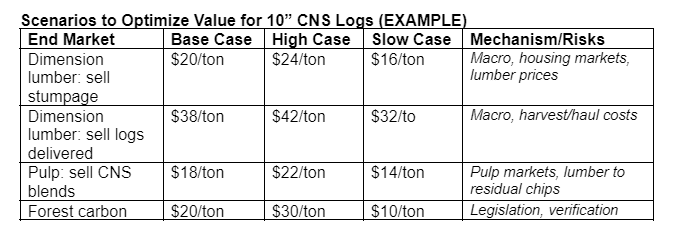Given the variety of timber markets, wood-using mills, and forest supplies across regions, how do we organize our thinking for deciding what to do with our timberlands? This article summarizes three approaches.
Have a Simple Framework for Understanding How Things Work
The late author and management “thinker” Peter Drucker wrote “The purpose of business is to create and keep a customer.” Drucker taught that every activity, to the extent possible, should support and add value to those objectives.
At Forisk, we have a simple model. Conduct and deliver forest industry research relevant to clients, and support clients in applying this research to make better decisions. Our day-to-day activities prioritize research quality, the delivery of this research, and supporting clients in their use of it. We do our best to prune the rest.
How might we frame the forest products industry? The economics point to a set of simple, overlapping models that accept the fact that wood is heavy. Distance and the ability-to-pay for wood drive value and risk. For example, logging and hauling, to quote a late colleague, is about “getting rubber under the wood.” Timber management is about maximizing value per acre, which is a function of growing and selling logs to mills that can buy those logs and turn them into something else at a profit, which is largely a function of, to bring it full circle, mileage and manufacturing margins.
Having a clear and clean understanding of how things work helps us choose appropriate questions, which in turn creates a need for relevant information and benchmarks.
Support Cooperatives and Benchmarking
In forestry, we often gain more from participation than from secrecy. Aside from confidential mergers, transactions, and personnel decisions, the operational and asset management aspects of forestry benefit from pooling resources. Anything we do to enhance viability, sustainability, and career opportunities supports the long-term.
At Forisk, we support and subscribe to cooperative research, such as supply modeling at SOFAC and timberland investment benchmarking at NCREIF. We are members of and participate in multiple forest industry associations, where we learn, network, and share. In addition, we conduct and deliver timberland management and silviculture research, which now includes dozens of participating firms and over 36 million U.S. acres.
Supporting well-organized and relevant cooperative research is efficient. It mitigates risk and enhances value, especially when we leverage this in our scenario planning.
Develop Detailed Scenarios
For firms that own forests and mills, realizing value from a given timber market is a localized resource allocation exercise. Previously, we posted basic models for framing the fundamentals, from volume-based scenarios to those focused on value-per-acre. Making better forest management and investment decisions relies on the detailed application of relevant information and experience.
Detailed scenarios test our thinking through the upside and downside associated with factors in and out of our control. Consider log-by-log (spec-by-spec) outlooks by basin with potential log prices and realizations. Breaking down assumptions across scenarios makes visible the value drivers and implications. For example, consider this approach for a 10” DBH chip-n-saw log in a Southern timber market or wood basket:

Scenario planning reminds us that resources are limited and committing to priorities is difficult. If all mills upgrade (in a region), then lumber production variance is more a function of the local resource (who can buy cheaper logs easier or who can manufacture product more efficiently) than it is of beetles or fires in Canada. Scenarios help us build these stories from the ground up to stack our options and make firm decisions.
What is the best way to preserve forests? We only need a reasonable and defensible answer. We need intuition and experience how things work from the ground up to develop and test reasonable projections and decisions. Understand your data, frameworks, and models.
Efficient and knowledgeable management support success and profits. To me, each word is important. Efficient means reduce waste; knowledgeable means apply insight and experience; management refers to good decisions and implementation with our teams and operations.
Simply, I have come to believe that, at least in forestry, our sector tends to grow and learn better together, that through certain areas of collaboration and cooperation we build better teams, more efficient operations, and a healthier industry. From there, we live another day to tell our stories and help others succeed, as well.
This content may not be used or reproduced in any manner whatsoever, in part or in whole, without written permission of LANDTHINK. Use of this content without permission is a violation of federal copyright law. The articles, posts, comments, opinions and information provided by LANDTHINK are for informational and research purposes only and DOES NOT substitute or coincide with the advice of an attorney, accountant, real estate broker or any other licensed real estate professional. LANDTHINK strongly advises visitors and readers to seek their own professional guidance and advice related to buying, investing in or selling real estate.










Add Comment